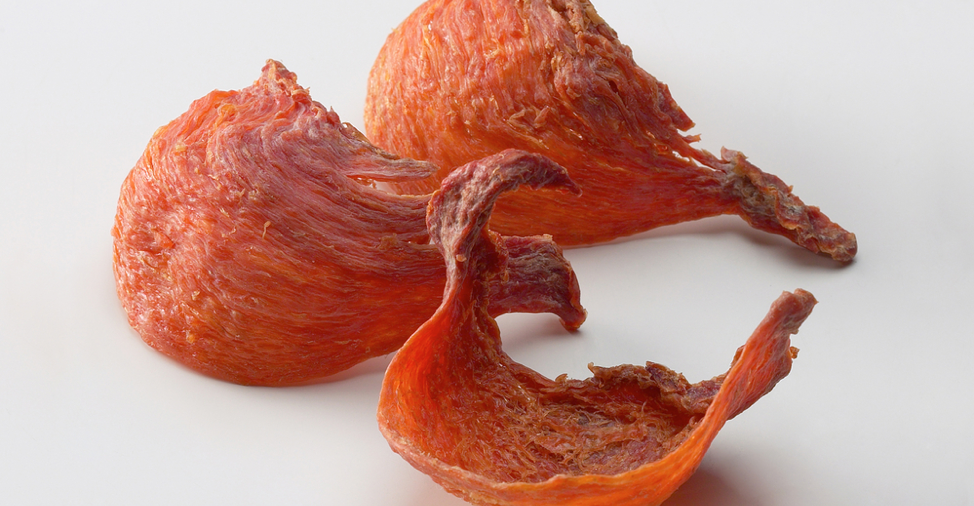Edible bird’s nests or cubiloses are treasured as a health tonic and gastronomic delicacy in Chinese cuisine. They are produced by certain swiftlets as they secrete a ‘nest cement’ from salivary glands for the construction of their nests. The nest cement is soft and sticky when fresh, but gradually dries and hardens when exposed to air. The major component in nest cement is sialic acid-rich glycoproteins.1
Typically, edible bird’s nest range from being dull white or dirty white to somewhat dull yellowish. Occasionally, in caves and swiftlet houses, there are some samples that are partially or completely dull orange-red to brownish red. These red edible bird’s nest are called Xueyan or Xueyanwo (blood swiftlet or blood swiftlet nest) in Chinese or red ‘blood’ nests in the West.1
The origin of the red colour in edible bird’s nest has been surrounded by legend and myth. A century-old legend claims that the red colour came from the blood in the saliva of exhausted swiftlets hurrying to finish their nests before laying eggs.2 Seen as a superior form of the nest, red edible bird’s nest are traditionally promoted as having higher beneficial value to health. Red edible bird’s nest even fetch a higher price than the white ones and regarded as premium in the market.
Despite its superior claim, red edible bird’s nest may be a naturally occurring phenomenon due to exposure to certain environmental factors. In Indonesia, as a result of the lucrative economic return from red edible bird’s nest, large quantities of red edible bird’s nest are produced through exposing white edible bird’s nest to vapours from ‘bird soil’ by fumigation under dark, enclosed, warm and humid conditions. This may be to replicate the conditions deep in the cave, where the nest is exposed naturally to “bird soils”. There might be a link between the reddening in edible bird’s nest by exposure to bird soil and the nitrites component of the bird’s soil, as high nitrite levels are detected in red edible bird’s nest.
In fact, the vapour from the bird soil contains reactive nitrogen species or RNS like nitrous acid produced by bacterial decomposition of the protein and nitrogen-rich bird soil. Nitrous acid readily reacts with tyrosine present in the mucin glycoprotein of edible bird’s nest to form nitrated tyrosine which is rich in color. The nitrated tyrosine, is found to be practically absent in the white bird’s nests but present significantly in the red bird’s nests. Therefore, the nitration of tyrosine is believed to cause the change of colour of edible bird’s nest. To elucidate this assumption, a study involving the science of exposing white edible bird’s nest to nitrous acid was published in the Journal of Agricultural and Food Chemistry.3
Through the study, exposure of edible bird’s nest to nitrous acid was conducted through fumigation of the white edible’s bird nest with chemically synthesized RNS. The white edible bird’s nest turned yellow/golden after 1 day, orange-red after 5 days, and gradually a terracotta red over a period of 30 days. The concentration of nitrated tyrosine and nitrites were reported to increase in the edible’s bird nest as fumigation continued.
RNS, which has a harmful effect in the human body may be eliminated more efficiently by white edible’s bird nest than the red one through binding with tyrosine.4 Therefore, due to the fact that white edible bird’s nest has more than 99% of the tyrosine residue available whilst the yellow, golden, orange, or red nests have a portion of the tyrosine residues already nitrated, the claim that red edible bird’s nest has superior health benefits may not only be misleading but also contradictory to the science behind it.
The antioxidant property of edible bird’s nest which surpassed black garlic, ginseng, or goji berry is also partly dependent on the tyrosine in mucin glycoprotein. In conclusion, white edible bird’s nest is a stronger antioxidant compared to red edible’s bird nest due to the higher availability of tyrosine to take up free reactive oxidants.
References:
1 But P, Jiang R, Shaw P. Edible bird’s nests—How do the red ones get red?. J Ethnopharmacol. 2013;145(1):378-380. doi:10.1016/j.jep.2012.10.050
2 What is a Blood Bird’s Nest?. Golden Nest Inc. Published 2018. Accessed December 19, 2018.
3 Di Meo S, Reed T, Venditti P, Victor V. Role of ROS and RNS Sources in Physiological and Pathological Conditions. Oxid Med Cell Longev. 2016;2016:1-44. doi:10.1155/2016/1245049
4 Shim E, Lee S. Nitration of Tyrosine in the Mucin Glycoprotein of Edible Bird’s Nest Changes Its Color from White to Red. J Agric Food Chem. 2018;66(22):5654-5662. doi:10.1021/acs.jafc.8b01619

